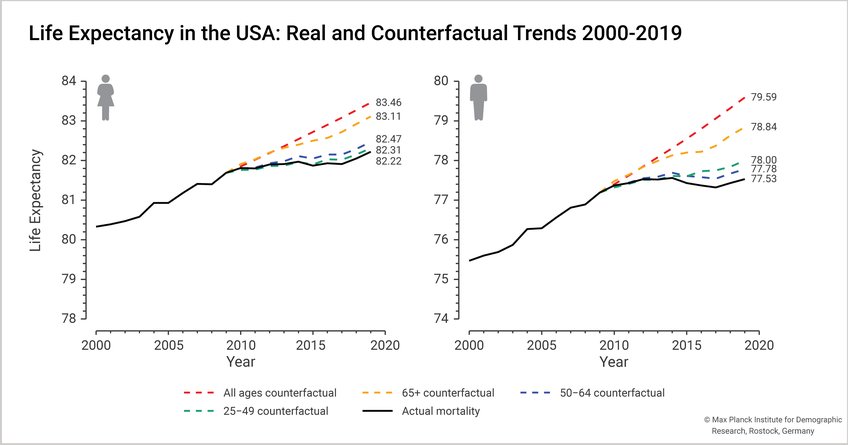Study identifies increase mortality at ages 65 and older as driving force
Life expectancy in the U.S. has stopped increasing since 2010, after decades of steady increase. Meanwhile, most other countries have continued to experience improvements in life expectancy. Previous research has suggested that the poor performance of U.S. is because of high mortality of the working age population. A new study shows that the most important reason for the stagnating life expectancy is high mortality in retirement ages. This has serious implications for life expectancy in the United States.
In the current , researchers from Tufts University, Medford (USA), the Max Planck Institute for Demographic Research (MPIDR) in Rostock (Germany) and the University of Texas Medical Branch (USA) have investigated why life expectancy in the USA is not increasing as strongly as in other countries and which age groups are responsible for this. Using data from the , they evaluated annual mortality rates in the U.S. for the years 2000 to 2019 by sex and age group. The researchers compared 2000 to 2009 and 2010 to 2019. For the 2010 to 2019 period, they also calculated what life expectancy would have hypothetically been if age-specific mortality rates had continued to increase as in previous years.
The study provides evidence that the 65+ age group has played a key role in the stagnation of life expectancy in the United States since 2010. “Much of the research on U.S. mortality has focused on working-age adults. This is because deaths from drug overdose, addiction and suicide, as well as cardiovascular and metabolic diseases, rise sharply in middle age. In our study, we show that mortality trends starting at age 65 play a larger role in the stagnation of life expectancy, as well as excess mortality and years of life lost in 2019. Our findings suggest that the U.S. faces a ‘double jeopardy’ from both midlife and old-age mortality trends, with the latter being more severe,” says Mikko Myrskylä, director of MPIDR.

The figure shows the real and the counterfactual life expectancy at the age of 25 for the years 2000 to 2019.
© MPIDR
Currently, research and policy in the U.S. is focused primarily on the opioid epidemic and related deaths. Uncovering the impact of mortality in old age has far-reaching implications for policy. “Clearly, the same causes that lead to increases in working-age mortality also contribute to increases in mortality at older ages. However, health-related causes such as cardiovascular disease are more important in the elderly. They are a major cause of the stagnation in life expectancy in the United States. About two-thirds of these deaths occur after age 75. Risk factors such as smoking, physical inactivity, obesity and diabetes may play a key role,” says Leah Abrams, the lead author of the study. Lack of access to good medical care is another factor that can significantly reduce the life expectancy of older people.
“In order for life expectancy to increase as rapidly in the future as it has in the past, the causes of increased mortality after age 65 need to be better understood and addressed. Future research should specifically compare the causes of death and the upstream factors that contribute to the unfavorable mortality trends in working age and old age,” says Neil Mehta who is a co-author of the study.
Open Data
Data used in this analysis are publicly available from the . Code and documentation are available at this .








